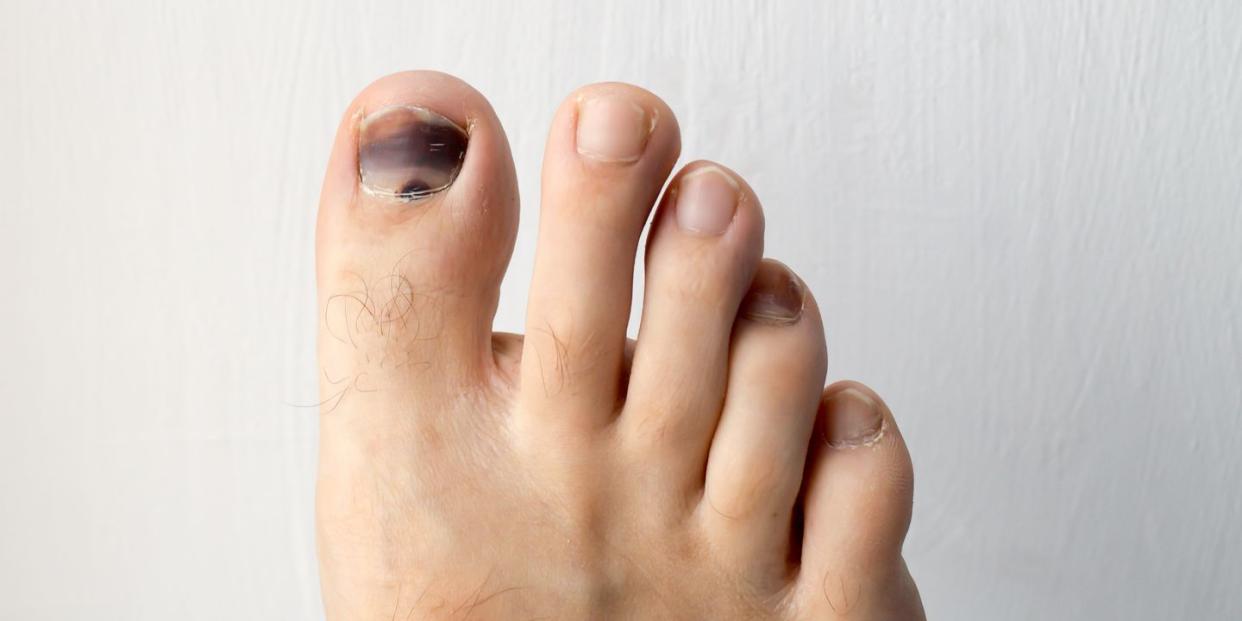5 Reasons You’re Dealing With a Black Toenail, According to a Dermatologist

Your nails can say a lot about your health: Discoloration, brittleness, and breakage are annoying to deal with on your fingers, but they’re also signs you should watch out for on your toes. One problem you definitely shouldn’t ignore? A black toenail. Sure, it can be a cosmetic nightmare when you want to rock your favorite comfy sandals, but it can also signal a potentially serious problem.
“If we’re talking about just one black toenail, there are some reasons that are concerning, and there are some that are very benign,” explains Nava Greenfield, M.D., a dermatologist at Schweiger Dermatology Group in New York City. “I ask myself, ‘Am I seeing the black toenails on both sides of the feet, or just one toe? Is it symmetrical?’”
Discolored toenails are pretty common, Dr. Greenfield says, so don’t feel embarrassed or ashamed—the condition is likely no fault of your own. Below, common causes of a black toenail, and why it’s important to get professional treatment.
What are the causes of a black toenail?

A wart could be stirring up trouble.
Warts are skin growths caused by a type of human papillomavirus (HPV) and they’re typically harmless. But warts that pop up under toenails will start to raise them from the skin, making treatment crucial. Periungual warts, in particular, can cause nails to look like cauliflower, thicken the skin around the nail, and cause fissures. While these are usually brown or yellow, they can turn black due to debris buildup.
“They’re tricky,” Dr. Greenfield says. “It’s hard to treat a wart under the toenail.” Her go-to option include injections under the toenail and oral medications, which can clear the wart in weeks to months. It’s important to be cautious at this time, as warts are contagious, even during treatment.
A fungal infection may have developed.
While toenail fungus is less than ideal, it’s one of the more harmless causes of a black toenail, according to Dr. Greenfield. When fungi get beneath your toenails—say, from wearing wet shoes all day, having sweaty feet, or spending a lot of time in water—they may set up shop and cause an infection, which can result in discoloration and often brittle, ragged, or thickened nails.
There are plenty of home remedies you can try to take care of the problem (Dr. Greenfield often recommends soaking the affected toes in vinegar), but if it persists, your dermatologist can take a closer look to ensure you’re accurately diagnosed and treated with the best medication for your specific problem. This will resolve the issue as soon as possible—usually within six months.
You have runner’s toe.
This condition, which looks like a bruise beneath the toenail, is common in the big toe and the second toe, both of which endure repetitive trauma when you run frequently. (In fact, runner’s toes are almost a badge of honor for those who are ramping up their training.) It’s caused by a blood blister beneath the nail and happens more often if your nails are too long or your shoes are a bit too tight.
Runner’s toe usually clears up on its own over a few weeks or months, but we warned: It’s possible to lose a toenail, in which case you should reach out to a dermatologist or podiatrist to make sure you’re taking care of it properly to avoid infection.
It could be a harmless mole.
There’s not much you can do for a benign mole under your toenail. Just like the moles on the rest of your skin, they’re here to stay, Dr. Greenfield says. Still, be sure to follow up with your dermatologist for regular checks, to make sure it poses no risk to you. And if it truly bothers you, go ahead and cover it up with some nail polish if you want.
... or a cancerous mole.
Not all dark spots are cause for panic, but if’s asymmetrical, large, irregular in color, or changing in any way, sometimes testing is required to determine if it could be a sign of skin cancer. Melanoma, the deadliest form of the disease, can also begin as a dark, vertical line beneath the toenail, according to the American Academy of Dermatology.
“Melanocytes are cells that produce color in our skin,” Dr. Greenfield says. “This could be bad melanocytes [melanoma], or it could be OK, just like a mole under the toe.” If your dermatologist suspects melanoma, they might request a nail bed biopsy in which a piece of the toenail (or the whole thing) could be removed. But, Dr. Greenfield says, that’s a small price to pay for peace of mind.
?When to see a doctor about a black toenail
“If you’ve got a black toenail, you have to go to a dermatologist,” Dr. Greenfield stresses. “There’s no way you’re going to make that medical decision at home.” Without a proper diagnosis, you won’t have a way to determine what could be ailing you or whether the underlying problem could be serious.
Your dermatologist will search for patterns, determine if there’s anything underneath your black toenail, monitor the size of the discoloration, and make informed decisions for the best treatment options, which vary due to conditions and their severity.
Support from readers like you helps us do our best work. Go here to subscribe to Prevention and get 12 FREE gifts. And sign up for our FREE newsletter here for daily health, nutrition, and fitness advice.
You Might Also Like